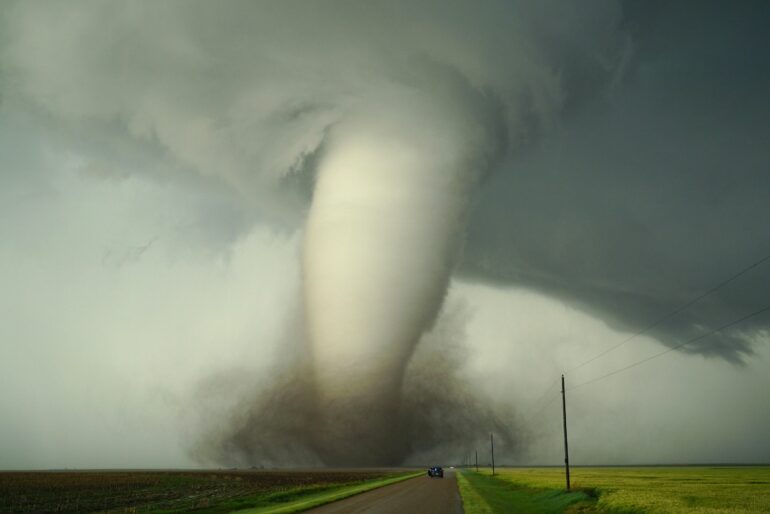Across the Midwest during the warmer months, studying the sky for signs of storms and tornadoes becomes one of the most popular pastimes.
Dan Chavas, an associate professor in the Department of Earth, Atmospheric, and Planetary Sciences at Purdue University’s College of Science, takes it further: All day every day, he studies what makes tornadoes tick. Working at the intersection of climate science and meteorology, he looks at the big picture of what causes severe storms and tornadoes—and what dictates where they occur.
“I study both the climate and extreme weather,” Chavas says. “My research asks, “Why do we have severe thunderstorms or tornadoes at all?” There are specific regions on Earth that have more storms, more tornadoes than other places. What creates these stormy regions?”
The central and eastern regions of the United States are among the top spots for severe thunderstorms and form the hot spot for the Earth’s most damaging and frequent tornadoes. Chavas uses real-world computer models to conduct experiments to determine what contributes to the formation of these storms.
“We have had these decades-old assumptions about what causes storms,” he says. “We’re validating those hypotheses and figuring out what makes North America such a hot spot.”
Moving heaven and earth
Chavas isn’t a storm chaser. He’s not out there in a weather van topped with satellite wires hunting down individual storms for the insights they might yield. Nor can he grow storms in his lab or unleash tornadoes to understand their anatomy or behavior.
Instead, he harnesses decades of rich, detailed historical data and complex computer models to imagine and test what-if scenarios. He’s a storm tester.
“We use weather and climate models, as well as extensive databases of thunderstorms, lightning strikes, atmospheric data and more, to ask, “What if the world was different?'” Chavas says. “We can use these models as laboratories to ask questions like ‘What happens to the weather if you flatten the Rocky Mountains? What about if you fill in the Gulf of Mexico? What aspects of the modern continental and mountain configurations really matter? Let’s actually test this prevailing, conventional wisdom.'”
Both of those hypotheticals—flattening the Rockies and filling in the Gulf of Mexico—are the focus of studies Chavas and his team have conducted.
For more than 50 years, established wisdom said that the Gulf of Mexico, a source of warm, wet air flowing inland to the east of the Rocky Mountains, plays a major role in the formation of North America’s tornadoes. But no one knew for sure.
“It was a very reasonable hypothesis,” Chavas says. “There were a lot of very reasonable explanations. But no one had been able to test these 50-year-old ideas because they came about when there weren’t climate models with the necessary computational power. Now we can really start to understand the physics of the situation.”
When his team virtually filled in the Gulf of Mexico with land, they found that a dry Gulf of Mexico affected the frequency and severity of storms far less than they had expected. Without the Gulf of Mexico, severe thunderstorms shifted eastward from the central Great Plains into Illinois, although they were reduced over southern Texas.
“Severe thunderstorms and tornadoes form in environments with specific ingredients for how temperature, moisture, and especially wind speed and direction change with height in the atmosphere,” Chavas says.
“The climate determines where and when those ingredients can be found together to produce these types of storms. Computer models let us understand why the ingredients are there in the first place and what role they each play in the weather we see.”
In his most recent study with graduate student Funing Li, published in the Proceedings of the National Academy of Sciences, the team compared severe weather potential in North America, famous for tornadoes, with South America, which has a geography similar to North America’s and also many severe thunderstorms, but far fewer tornadoes.
They found that the rough texture of the land surface east of the Andes mountains, its roughness determined in part by the hills and tall trees of the Amazon region, may play a large role in preventing tornadoes over central South America. In contrast, in North America many tornadoes form east of the Rockies, where air flows in from the much smoother ocean surface of the Gulf of Mexico.
The team first used climate model experiments in which equatorial South America was smoothed to be similar to an ocean surface, which drastically increased central South America’s tornado potential. They also performed experiments in which the Gulf of Mexico region was roughened to be similar to a forested land surface, which strongly suppressed North American tornado potential.
“A rough surface upstream means that downstream the wind is no longer changing speed and direction with height very strongly near the surface, which we refer to as ‘wind shear,'” Chavas says. “It doesn’t change ingredients for severe thunderstorms, but the wind shear in the 1 kilometer of air above the ground is a critical ingredient for tornadoes.”
Storm warning
Real weather and real-world applications fascinate Chavas, a fascination born after a storm-torn tree fell on his house in Wisconsin when he was 4 years old.
The real-world implications of his research—what will the weather be like next week, next month, next year and next century—are what drives him.
“If we want to understand how climate change will affect weather in the future, we need to understand how climate determines weather in the first place,” Chavas says. “We don’t have a very good understanding of how climate controls the severe weather we have.”
Understanding how surface roughness and land use changes weather, for example, may enable future humans to better predict—and even partially affect—weather patterns. If the rough land of the Amazon, including a component from the trees of the Amazon, protects South America from tornadoes, could the regrowth of the United States’ eastern forests affect tornadoes, too?
Climate change affects the flow patterns of the atmosphere and moisture distribution on land, Chavas says.
“If we change the land surface and the trajectory of air flowing inland from the Gulf of Mexico, it may have a direct impact on these ingredients that give rise to tornadoes farther inland. When we think about climate change, we think about it getting hotter and the land getting drier.
“But if the jet stream changes where and how quickly air flows inland, it can change where and how tornadoes form. Places that didn’t see them before may see them more, and places that had more may see fewer,” he says. “We need to understand the weather now to help us better predict the weather of the future.”
More information:
Funing Li et al, Upstream surface roughness and terrain are strong drivers of contrast in tornado potential between North and South America, Proceedings of the National Academy of Sciences (2024). DOI: 10.1073/pnas.2315425121
Citation:
New twists on tornadoes: Earth scientist studies why U.S. has so many tornadoes (2024, June 27)



